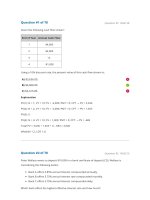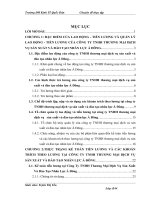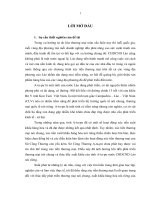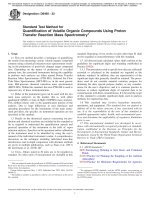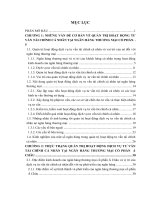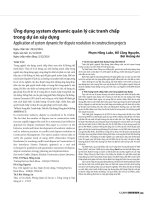Solution manual of environmental chemistry a global perspective 4th ch19
Bạn đang xem bản rút gọn của tài liệu. Xem và tải ngay bản đầy đủ của tài liệu tại đây (288.06 KB, 7 trang )
Solutions: Environmental Chemistry - a global perspective 4th Edition
Chapter 19
The chemistry of solid wastes
PROBLEMS / SOLUTIONS
1.
The ‘Trelogan’ tailings1 are associated with a calcareous lead / zinc deposit in Britain and have the
properties shown.
pH = 7.0; CEC = 2.8 cmol (+) kg–1; conductivity = 2.3 dSm–1
Describe the nature of any expected physical and chemical problems associated with revegetation of
these tailings, and how the problems might be overcome.
Particle size / mm
>2
Percentage of total
6.7
2.0–0.2
14.6
0.2–0.02
29.7
0.02–0.002
24.8
> 0.002
24.2
Total analysis of tailings
Element
g g–1
Element
g g–1
Element
g g–1
Element
g g–1
N
126
Ca
138 500
Cu
205
Pb
39 800
P
160
Mg
1500
Cd
267
Zn
95 000
K
1070
185
Ni
87
F
Solution
Based on the particle size data (Figure 18.1) and the soil classification as a loam (47% sand, 27% silt and
26% clay) from Figure 18.2, this would indicate that the soil should be easily worked, but would likely also
have reasonable moisture-retaining ability. Chemical reactivity would depend on the nature of the claysized materials. In this case, the fine materials have only very limited CEC. The tailings would also have no
organic matter, which would have to be added to aid in nutrient holding capability, increase the CEC and
add structure to the soil. Sufficient quantities of both major and minor nutrients are present under neutral
pH conditions. However, elevated concentrations of Pb and Zn are also present as well as of other metals
such as Cu and Cd and Ni. These metals need to be immobilized. The addition of good quality sewage
sludge could aid in increasing organic matter content, without increasing metal concentrations significantly,
and this would aid in retention of the metals. Hydrous iron or aluminium oxides would also contribute to
retention.
Al2O3 + 2SiO2 + Pb2+ + 3H2O → PbO•Al2O3 + 2SiO2 + 2H3O+
1
Data adapted from Additional Resources 1.
163
Solutions: Environmental Chemistry - a global perspective 4th Edition
Chapter 19
The chemistry of solid wastes
Grasses and shrubs could be grown, but no agricultural crops for human or animal consumption would be
possible, as the retained metals would be partly available for uptake by plants.
2. Use the data in Table 19.3 to estimate the C:N ratio in cattle manure. Compare the value with that given
in Table 19.4.
Solution
30 kg of cattle manure with 10% total solids gives 3 kg of solids. An estimate of 60% C gives 1800 g of C.
The amount of N is reported (Table 19.3) as 140 g N.
The C:N ratio would then be: 1800:140 or approximately 13:1. This is near the 20:1 value reported in
Table 19-4.
3.
Arsenic is often associated with sulfide minerals. Because of this, significant amounts of arsenic may
be discarded along with the tailings from mining operations involving these minerals. Refer to the
material provided in Chapter 10, Problem 9, and indicate what species of arsenic would initially be
present in the tailings, and what species might be generated over time.
Solution
The arsenic species that is likely present in the tailings initially is H 2AsO4-. The acid mine tailing produced
from sulifide minerals would have a high pE and low pH. Over time, the conditions may change to low pE
and low pH and thereby generating the H3AsO3 species.
4.
The nickel pE / pH diagram is shown in Fig. 19.P.1. Included in setting up the diagram is a
concentration of Ni2+ of 10–4 mol L–1 and a total S concentration of 10–3 mol L–1. Predict the
environmental fate of Ni discharged as the mineral NiS if it is disposed into a well-aerated tailings
pond or, alternatively, if it is placed at the bottom of a deep lake.
164
Solutions: Environmental Chemistry - a global perspective 4th Edition
Chapter 19
The chemistry of solid wastes
Fig. 19.P.1 Nickel pE / pH diagram.
Solution
The pE / pH diagram indicates that under the conditions of a well-aerated tailings pond, the predominate
form of nickel would be Ni2+. The addition of NiS to this pond would allow for the dissolution of the
compound to form Ni2+ and possibly forming one of the oxides or hydrous oxides of nickel. Addition of
NiS to the bottom of a deep lake, where conditions would include low pE and likely a neutral pH, suggest
that no change would take place. NiS would be stable under these conditions.
5.
If the acidic leachate from sulfide tailings flows in a stream along the surface of the land, it is
frequently observed that a red-brown deposit is found downstream on the rocks or sediment in the
stream bed. Discuss the chemistry that might explain this observation.
Solution
The red-brown deposit that are found downstream on the rocks or sediments in a stream bed that result
from an acidic sulfide tailing leachate can be explained by the formation of iron(III) hydroxide.
The sulfide tailings likely contain pyrite FeS2, which is oxidized in air to give:
2FeS2 + 7O2 + 6H2O → 2Fe2+ + 4SO42- + 4H3O+
The acid tolerant iron oxidizing bacteria Thiobacillus ferrooxidans is then responsible for oxidation of the
iron(II) released in the initial step.
165
Solutions: Environmental Chemistry - a global perspective 4th Edition
Chapter 19
The chemistry of solid wastes
4Fe2+ + O2 + 4H3O+ → 4Fe3+ + 6H2O
The iron(III) that is formed acts as an oxidizing agent and further reacts with solid pyrite, without the need
of molecular oxygen.
FeS2 + 14Fe3+ + 24H2O → 15Fe2+ + 2SO42- + 16H3O+
The rate determining step is the oxidation of iron(II) to iron(III). The sum of these two reactions gives the
initial reaction. Therefore the three processes, taken together, describe a self-accelerating sequence of
oxidation of pyrite.
2FeS2 + 7O2 + 6H2O → 2Fe2+ + 4SO42- + 4H3O+
Because aqueous iron(III) readily loses protons, unless the pH is extremely low (as it can be within the
tailings deposit itself), oxidation of iron(II) forms a solid product often given the approximate formula
Fe(OH)3. Deposits of this solid are often observed where the leachate has moved downstream from the
highly acid tailings.
4Fe2+ + O2 + 18H2O → 4Fe(OH)3 + 8H3O+
6.
Use values of the acid dissociation constants for aluminium aquo complexes to calculate the solubility
of aluminium in red mud leachate that has a pH of 10.3.
Solution
The values of the acid dissociation constants for the aluminium aquo complexes can vary widely from
source to source. Appendix B.4 has only the first of these values (Ka1) and is different from the ones used
below to answer this question.
Red mud leachate with pH = 10.3 - what is the solubility of aluminium?
Using the abbreviated form of H+, the aluminium aquo complex under goes the following set of reactions
Al3+ + H2O
AlOH2+ + H2O
AlOH2+ + H+
Al(OH)2+ + H+
Ka1 = 1.02 x 10-5
Ka2 = 7.26 x 10-6
Al(OH)2+ + H2O
Al(OH)3 + H+
Ka3 = 5.13 x 10-8
Al(OH)3 + H2O
Al(OH)4- + H+
Ka4 = 1.82 x 10-5
In Chapter 16, Figure 16.3 shows that at pH 10.3 the Al(OH) 4- form of aluminium will be the most
dominant and the other forms will not be significant. The estimated concentration of aluminium from the
graph is log CAl = -3.1 = 7.9 x 10-4 mol L-1 Al.
Assume the form of aluminium is Al(OH)3 (s) that is in equilibrium with the leachate aluminium. Using
the solubility constant for aluminium hydroxide, first calculate the amount of soluble Al3+.
Al(OH)3 (s)
Al3+ (aq) + 3OH- (aq)
Ksp = 5.75 x 10-34
166
Solutions: Environmental Chemistry - a global perspective 4th Edition
Chapter 19
The chemistry of solid wastes
[Al3+] x [OH-]3 = 5.75 x 10-34
([OH-] = 2.0 x 10-4 from pH 10.3)
[Al3+] = 7.2 x 10-23
Al3+ + 4H2O
Al(OH)4- + 4H+
β4 = 6.91 x 10-23
β4 = Ka1 x Ka2 x Ka3 x Ka4
[Al(OH)4-][H+]4
β4 = ---------------------- = 6.91 x 10-23
[Al3+]
6.91 x 10-23 x [Al3+]
6.91 x 10-23 x 7.2 x 10-23
[Al(OH)4-] = -------------------------- = ------------------------------- = 7.9 x 10-4
[H+]4
(5.01 x 10-11)4
The [Al(OH)4-] can be assumed to be the total amount of all the aluminium dissolved species meaning the
solubility of aluminium is 7.9 x 10-4 mol L-1 (or 21 ppm Al) for the red mud leachate with a pH of 10.3. (the
same approximate amount that we determined from Figure 16.3)
7.
Describe the significance of the following properties in assessing the quality of compost: concentration
of carboxyl groups; carbon:nitrogen ratio; total phosphorus concentration; concentration of trace
metals.
Solution
Consider the quality of compost related to the following characteristics:
i) [COOH]
ii) C:N ratio
iii) TP & iv) trace metal concentration
i) A high concentration of carboxylic acid groups usually indicates that decomposition of the organic matter
is incomplete. This usually results from a situation where N is the limiting nutrient. This situation tends to
produce acetic, proprionic and n-butyric acids which are all phytotoxic. Hence the quality of compost is
poor if [COOH] is high. Under good compost conditions the residual COOH that is present will act as ion
exchange sites, holding both major cations and minor elements (often minor nutrients) within the organic
matter, adding to the fertilizer value of the compost.
ii) The C:N ratio of the raw materials is critical for controlling the rate and extent of composting reactions.
A large ratio means N is the limiting nutrient for microbial growth. As indicated in part i) this leads to a
partially degraded acidic material - a poor compost. A small C:N ratio means there is an excess amount of
N and this leads to ammonification and the release of NH3, and potentially a low pE environment. A value
of 30 for C:N is near optimum.
iii) P is an important macro-nutrient. The total phosphate (TP) concentration will be determined by the type
of raw material that is used for the compost. Typically it is not an important constituent in the production of
compost, but higher TP concentrations within the compost will generally provide a better quality of
compost.
167
Solutions: Environmental Chemistry - a global perspective 4th Edition
Chapter 19
The chemistry of solid wastes
iv) The concentration of trace metals in compost is important because some trace metals are nutrients, while
others can be toxins. Table 19.5 indicates that trace metal concentrations can be quite high.
8.
Consider two cases regarding a landfill.
(a) There is no collection system and the landfill gases are allowed to escape into the atmosphere.
(b) The gases are collected and flared off, with 83% efficiency.
Using data from Table 8.4 compare the relative global warming potentials (GWPs) of the gases
released in the two systems.
Solution
a) In the landfill where there is no collection system and gases are allowed to escape into the atmosphere,
methane (CH4) and carbon dioxide (CO2) are formed in a 1:1 molar amount, and are the two primary gases
involved with global warming (ignoring water vapour).
CO2
CH4
Fraction
GWP (p.189)
0.5
x
1
=
0.5
x 25
=
Total GWP
0.5
12.5
--------13.0
b) In the landfill where there is a collection system and the methane is converted to CO2 (at 83%
efficiency), the net relative amount of methane, would be
CH4
0.5 x 0.83 = 0.415 (converted to CO2), leaving 0.085 as CH4
CO2
CH4
Fraction
GWP
0.915 x 1
0.085 x 25
Total GWP
= 0.915 (note: the increased fraction of CO2 is from 0.83 x 0.5)
= 2.125
--------3.0
There is an approximate 77% reduction in the GWP from the gases that are released from a landfill where
the gases are flared off compared to those that are allow to just escape.
9.
At the United Nations Environment Program (UNEP) website, there is a graphical representation
showing composition of municipal solid waste in seven European countries and 7 large Asian
cities. Compare the composition of waste in Norway with that in Kathmandu (Nepal). Discuss
likely reasons for the differences and what strategies might be most appropriate for managing these
two types of waste. ( accessed September, 2016.)
Use the compositional data (above) and consult the Environment Section of the Eurostat yearbook
( accessed September, 2016.) to determine the total amount of metal,
glass, plastic and paper waste in Norway and the total amount of each recovered.
168
Solutions: Environmental Chemistry - a global perspective 4th Edition
Chapter 19
The chemistry of solid wastes
For classroom discussion, no solution provided. Include your own local comparisons and how you
might reduce the amount of material required to be landfilled.
A possible classification of metals in incinerator ash is based on their leachability. 2
10.
Ion exchangeable
Readily leached
Metals associated with oxides or carbonates
Can be leached under acidic conditions
Metals associated with iron and manganese
Can be leached under reducing conditions
Metals bound to sulfide or organic matter
Can be leached under strongly oxidizing conditions
Metals in the silicate lattice
Not leachable
Use your knowledge of metal association with solids to explain this classification system.
Solution
Ion exchangeable
Readily leached
Such metals are associated with ion exchange sites on the ash and can often be displaced by other common
ions such as Ca2+ or K+ that are present in the soil solution.
Metals associated with oxides or carbonates
Can be leached under acidic conditions
Ash materials like calcium carbonate or iron(III) oxide are soluble under acidic conditions. As they
dissolve, any other trace metals associated with the solids (on the surface or incorporated in the structure
as impurities) would also be released into solution.
Metals associated with iron and manganese
Can be leached under reducing conditions
Under reducing conditions, as we saw in Chapter 10, iron(III) and manganese(IV), whose hydrous oxides
are quite insoluble, can become more soluble iron(II) and manganese(II) respectively. As above, associated
metals would also go into solution.
Metals bound to sulfide or organic matter
Can be leached under strongly oxidizing conditions
Under oxidizing conditions, sulfide can be converted to sulfate, and solid organic matter can go into
solution as smaller organic degradation products, or can become carbon dioxide. Associated metals are
released.
Metals in the silicate lattice
Not leachable
Ultimately this is not exactly true as silicate minerals are slightly soluble. But the solubility is very small
and metals incorporated in the silicate lattice will be essentially immobilized and only very slowly released
into solution.
2
Fraser, J.L. and K.R. Lum, Availability of elements of environmental importance in incinerated sludge ash,
Environ. Sci. Technol., 17, (1983), 52–4.
169
